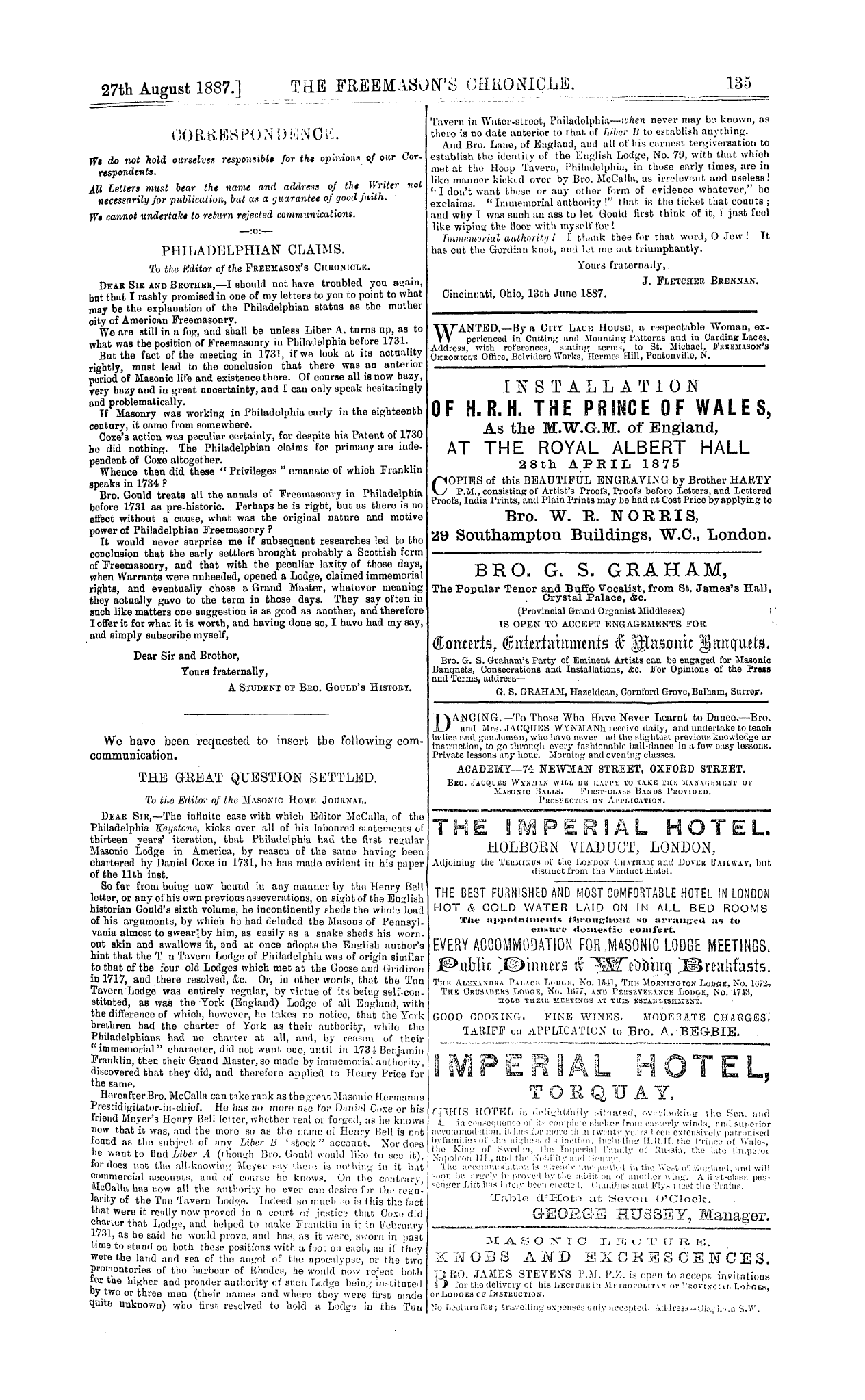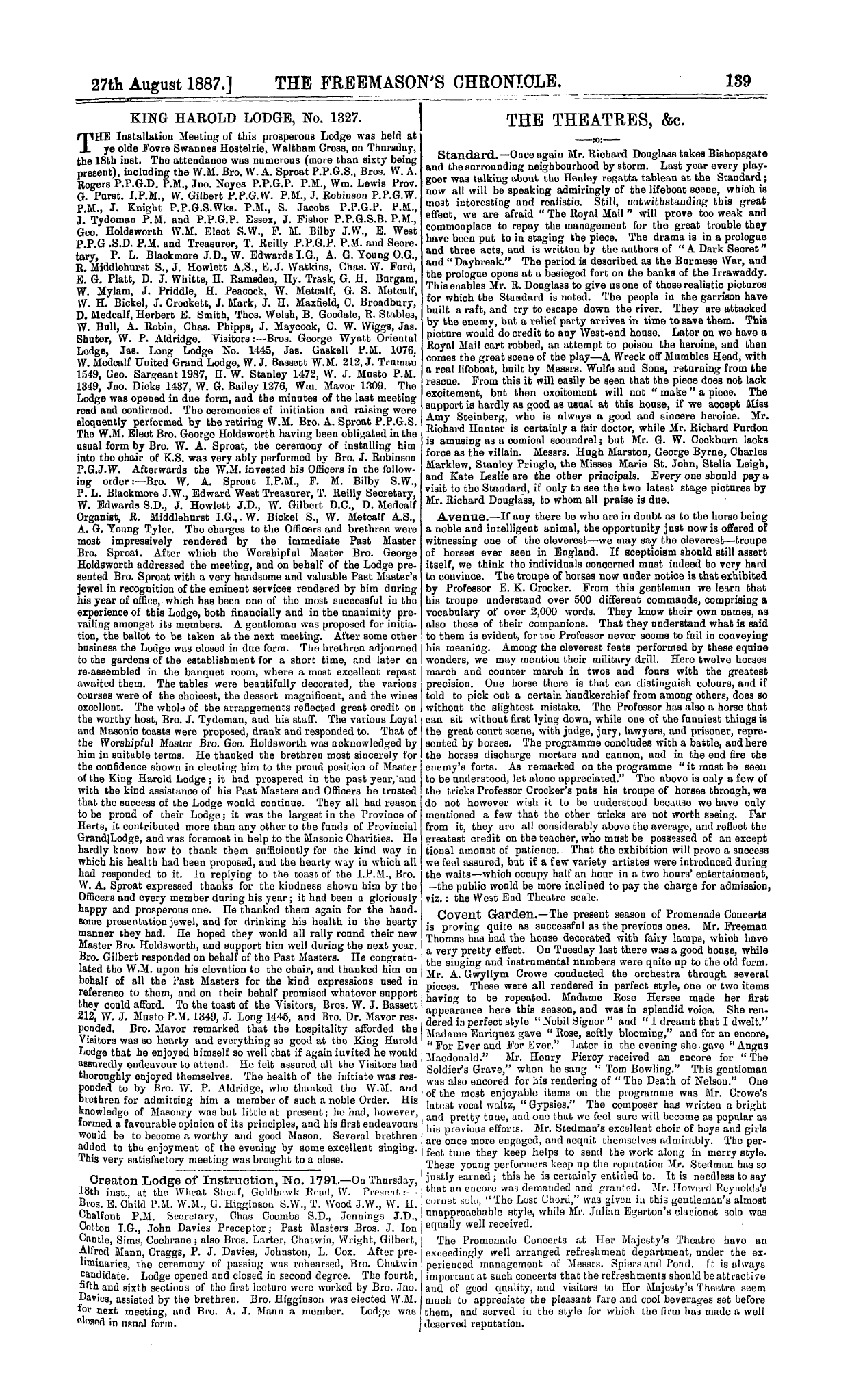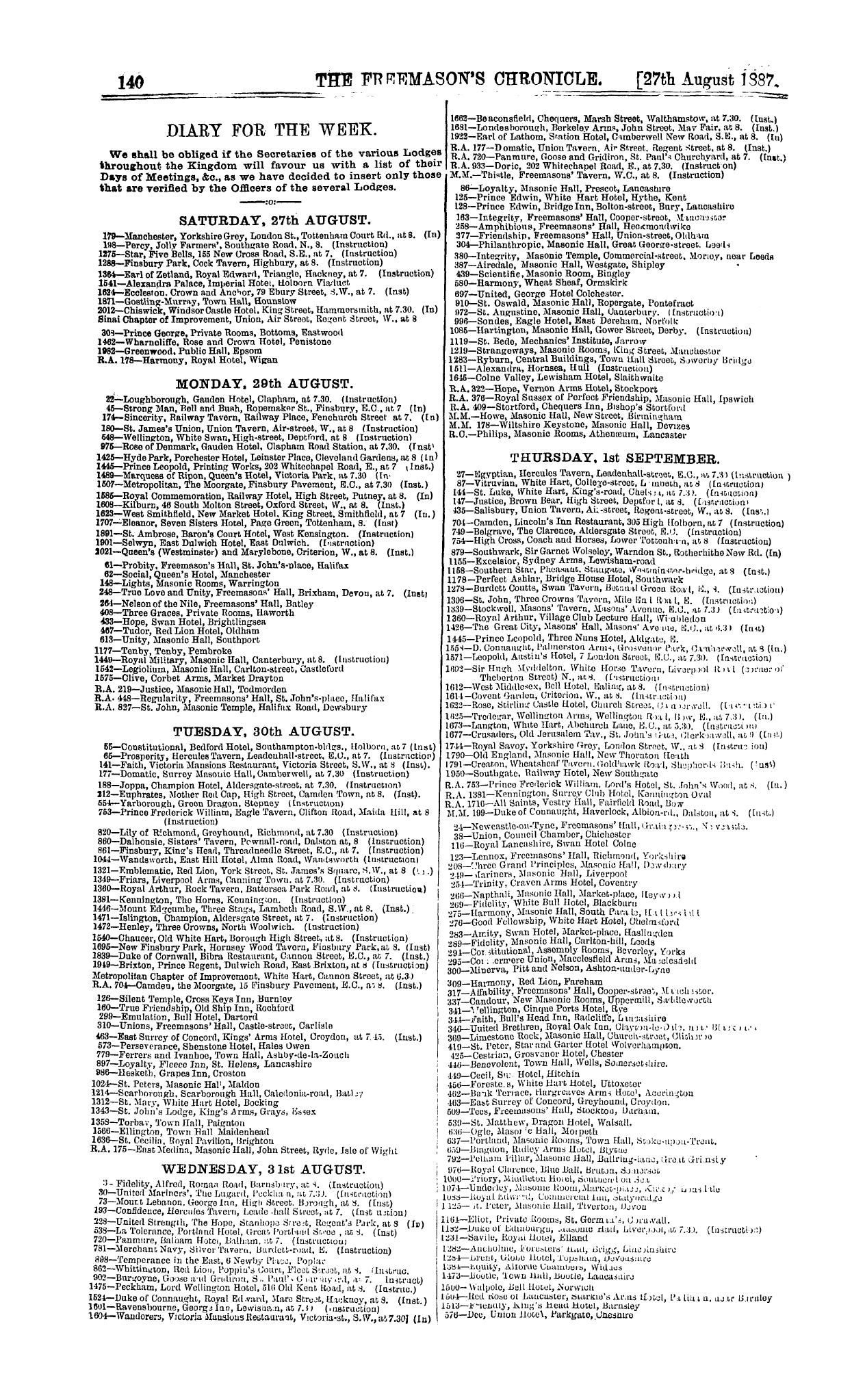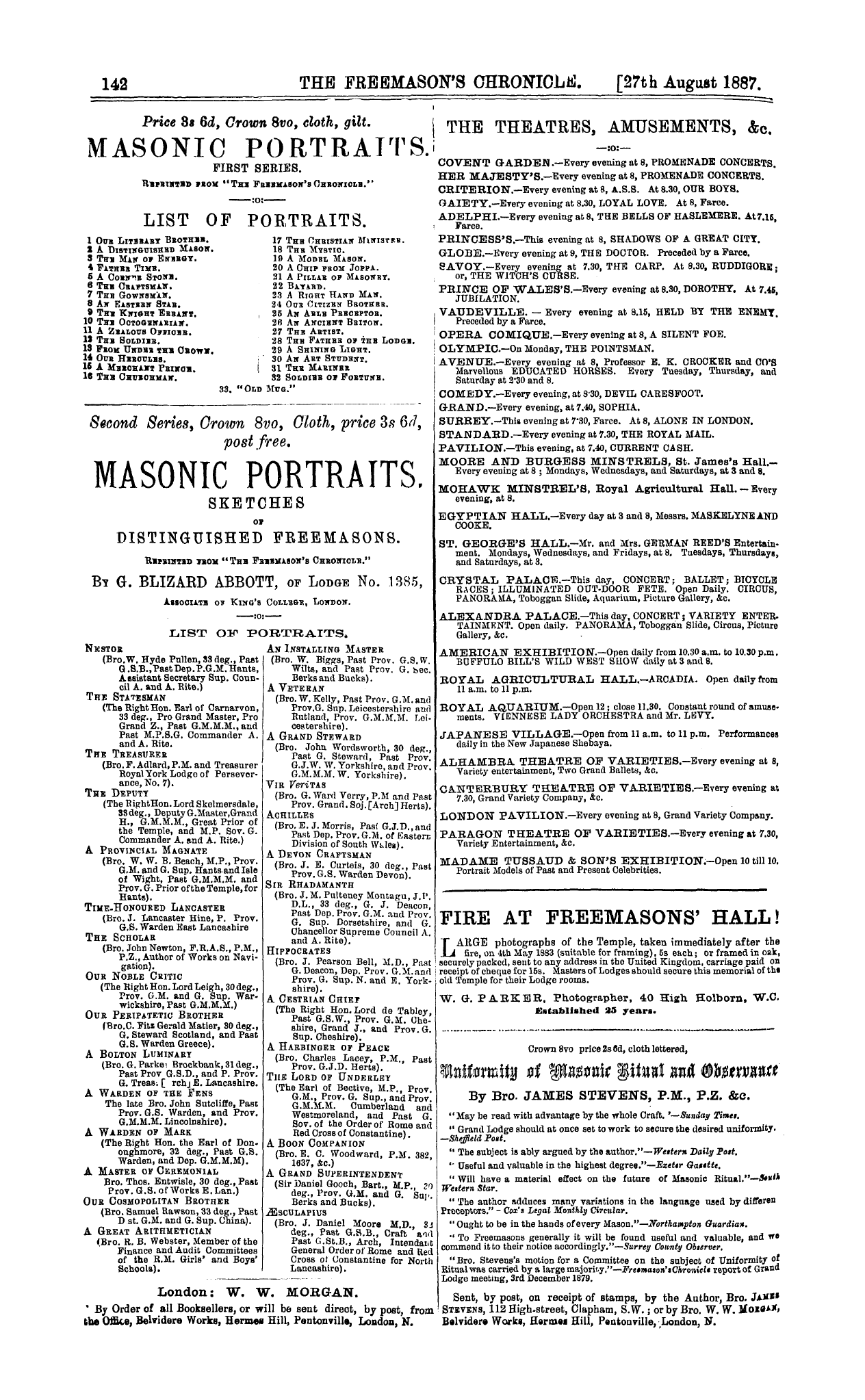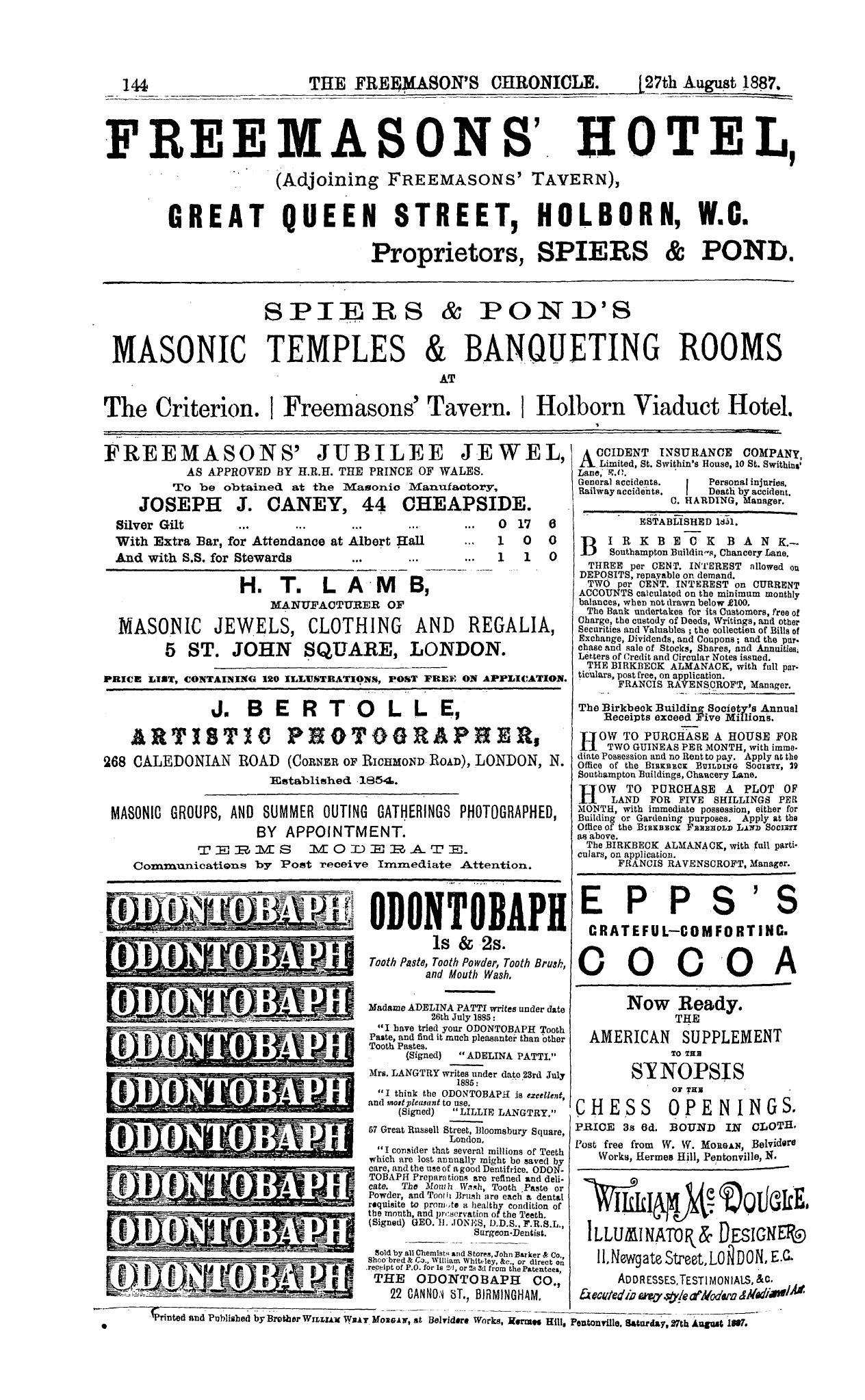-
Articles/Ads
Article OUR MASONIC GUILD LEGENDS. ← Page 2 of 2 Article ARCHITECTURE. Page 1 of 3 →
Note: This text has been automatically extracted via Optical Character Recognition (OCR) software.
Our Masonic Guild Legends.
probably as well , since truth often comes ont of collision of mind and view , and verification of theories and propositions can be educed from often seemingly the most , antagonistic contentions .
" •JJWe often are as " wide as the poles asunder , " as to the results of induction even , and the conclusions we respectively arrive at , and the only fear sometimes is , lest in our impetuosity or mistaken zeal for this side or the other of
a controversy , we substitute subjective for objective truth , or argue from an ingenious hypothesis as if it were a proved axiom of incontestable verity . So long as we confine ourselves to the pathway of reasonable induction , so long as
we guard ourselves by the legitimate canons of criticism and proof , all is well . It is only when we strive to establish the "idea" as "father to the thought , " or a special view of things for the exact facts of the case , that we are certain of misleading others , as well as ourselves .
For instance , some critics seem to forget that with such MSS . as those we have to deal with , similarity of expression is not always necessarily actual identity , and that the question of a common origin as regards MSS . always must
come . The mere use even of identical verbiage on these grounds proves often very little indeed , and nothing is so specious or so deceiving , because MS . A . agrees with MS . B ., therefore to assume that they are necessarily copies
of one another . On the other hand , we must not allow our belief in a possible common orig in to blind us to the fact , that one MS . may be after all only a transcript from another .
The Lansdowne and Dowland no doubt had a common
origin , and so had many more . Roberts ' s MS . and the Harleian MS . 1942 agree so much together , especially as regards the new articles , that it is not at all unreasonable or unnatural to say that Roberts ' s MS . is probably a copy of the Harleian .
If there be variations , they probably are simpl y " scribal , " and arise from carelessness , haste , or unskilfulness . Anderson saw a copy of the MS ., and though there may have been a common original , we
are inclined to treat the Harleian as the product of the Restoration period , based , no doubt , ou older records , but in itself a new departure , and therefore to some extent original .
All the legends depend on certain landmarks , points which they have in common , but which in some are more prominent than in others , and , according to experts , increase or diminish their value .
We are not quite certain that experts are right in this , but prefer to hold that MSS . must be taken for what , they profess to be . The Antiquity MS . has that reliable attestation clause which greatly adds to the value of its
testimony , and it is more than probable that a good deal yet may turn up about Wray and Padgett which will throw great li ght on the earlier history of " Old Antiquity . " In Bro . Gould ' s original history he laid down a canon
of value and acceptance as to MSS . not a little arbitrary , which many Masonic students only received , so to say , under protest . And for this reason . Such a canon affects the position and value of MSS . of the highest antiquity and
the greatest value , such as the Masonic Poem , Cooke MS ., the two Harleian , the two Sloane , the Lansdowne and Dowland , Lechmere , Papworth and the Golden Square MSS ., the Wood , Inigo Jones , & c , and raises above them some of the most modern and some of the least valuable .
And when , in addition to this , we have a new theory propounded , that certain MSS . are doubtful because they do not agree with certain theories of our own , and that even a taint of a " Franspia " may rest on some MSS . of the
safest custody , the clearest integrity and the greatest archfflological value , in the ingenious—may we not add perverse?—cleverness of some critics , we can only regret that such unsound views should prevail .
But we have this consolation . There is no snch thing as infallibilit y in human knowledge or even in Masonic controversy , and we feel convinced that in the long run
the value of actual and intellectual truth will prevail , however far-fetched the amusing speculations we have to listen to , however critically unsound the propositions and contentions we have to consider .
There are 17 symbolic Lodges in Egypt which work in the Arabic tongne . The grand object of Masonry is to promote the happiness of tho flnman race .
Architecture.
ARCHITECTURE .
An Address ly Ecv . James Byron Mim-in / , Grand Chaplain , before the Grand Chapter of Nav Yorl ; % ul Feb . 1887 . ( Continued from page 115 ) . / "CHINESE architecture like Chinese development
acl-\ J vaneed to a certain point , arid then like her civilization became seemingly transfixed and advanced no more . It is art in an undeveloped form . It is not the rude skill which marks tho earliest exhibitions of art , and which may
be combined with some grandeur of conception and beauty of detail ; but it is the growth of a taste which isalike hostile to culture and purity of design and tho grace of true
proportion . Its architecture is light and airy , but is not the expression of tho highest thought and tho home of a faith that vivifies the individual and the nation .
Hindoo architecture is grotesque and fanciful . It seeks to blend the stronger form of mm with tho delicacy of tho woman ; but it is weird and gloomv in its details , and
harmonised by no refined and cultured taste . It is not tho outgrowth of reverent ideas , and like its dark caves , is inspired by no hope . It is not . the shrine where man nourishes his yearning after immortality .
Egyptian architecture " -as more grand in its symbolism . It was colossai in its magnitude , and inspired a sense of awe by the darkness and massiveness of its temples . But though marked by strength and adherence to the law of
construction , there is no chastened purity of conception like that which is manifested in the work < of Greece . As a monument of the learning and thought of Egvnt . it i « , as its withered mummies , a dead record of a dead past . Its
most wondrous structure is the mausoleum or the tomb , for the thought of death was the one dominant thought of tho Egyptian . Life was only a passing shadow , not the magnificent gift to enlarge and make more glorious by its
achievements , and so fit , it for the higher life to come . If the Egyptian looked for immortality beyond , he always looked down to the p hysical , and sought to perpetuate life by preserving in death the outward , visible frame , and
thus his faith , his thought , hi-: science ended in the death of the body , and his most stupendous architecture partook of his gloomy visions , and was but the temple and tomb for the dead .
Grecian architecture in grace and delicacy of conception was altogether a higher order than that of Egypt or the distant East . The far seeing Greek mind , the poetic genius , the cultured reason , the power that developed tho human
form into nobler stature , uttered itself in what was refined , majestic and beautiful . The art of the East , with its fantastic grace , its marvellous blending of grandeur and delicacy , was regenerated and brought to full perfection
as it was touched by the Greek intellect , for Greece , ennobled by her philosophy , enriched by her splendid ideals and made graceful by the inspiration of beauty all that other nations contributed for art or use . The sculptured friezes of her
temples , the wildest conceptions of Eastern or Egyptian fancy were chastened and transfigured , as they expressed themselves in the Grecian temple . The Greek artist gave to architecture order , proportion and beauty . His public
buildings were the incarnation of richness and grace , delicacy and grandeur . By marvellous design and rarest sculpture , he immortalized those models of art which have glorified the artistic life of Greece and sent forth a standard
of perfection for all ages . Into her three great orders of architecture he moulded and fashioned the majesty and elegance , the refinement and splendour , which are the inspiration for man on his buildings for learning or worship . The first great order of Grecian architecture is the Doric .
I his is marked by the majesty of simplicity and the majesty of power . It combines the grandeur of the Egyptian with the strength and finely cultured taste of tho Greek . Unlike the Egyptian , if , is suggestive of intellectual force .
It is simple , but never fantastic ; plain , but never destitute of grace . It is severe in its proportion , but always characterised by dignify , and its temples are the embodiment of the largest conceptions of the supreme force and the magnificence of Greek thought .
The Ionic or second great order of architecture arose in the Asiatic colonies of Greece , and partook , in a measure of the rich and more languid climate of the East . The
simplicity of the Doric is lost in the chastened elegance of the Ionic . Delicacy of ornament marked its first structures ; but when transferred to Greece it rises into a marvel of grace and majesty of refinement . The massive and plainer
Note: This text has been automatically extracted via Optical Character Recognition (OCR) software.
Our Masonic Guild Legends.
probably as well , since truth often comes ont of collision of mind and view , and verification of theories and propositions can be educed from often seemingly the most , antagonistic contentions .
" •JJWe often are as " wide as the poles asunder , " as to the results of induction even , and the conclusions we respectively arrive at , and the only fear sometimes is , lest in our impetuosity or mistaken zeal for this side or the other of
a controversy , we substitute subjective for objective truth , or argue from an ingenious hypothesis as if it were a proved axiom of incontestable verity . So long as we confine ourselves to the pathway of reasonable induction , so long as
we guard ourselves by the legitimate canons of criticism and proof , all is well . It is only when we strive to establish the "idea" as "father to the thought , " or a special view of things for the exact facts of the case , that we are certain of misleading others , as well as ourselves .
For instance , some critics seem to forget that with such MSS . as those we have to deal with , similarity of expression is not always necessarily actual identity , and that the question of a common origin as regards MSS . always must
come . The mere use even of identical verbiage on these grounds proves often very little indeed , and nothing is so specious or so deceiving , because MS . A . agrees with MS . B ., therefore to assume that they are necessarily copies
of one another . On the other hand , we must not allow our belief in a possible common orig in to blind us to the fact , that one MS . may be after all only a transcript from another .
The Lansdowne and Dowland no doubt had a common
origin , and so had many more . Roberts ' s MS . and the Harleian MS . 1942 agree so much together , especially as regards the new articles , that it is not at all unreasonable or unnatural to say that Roberts ' s MS . is probably a copy of the Harleian .
If there be variations , they probably are simpl y " scribal , " and arise from carelessness , haste , or unskilfulness . Anderson saw a copy of the MS ., and though there may have been a common original , we
are inclined to treat the Harleian as the product of the Restoration period , based , no doubt , ou older records , but in itself a new departure , and therefore to some extent original .
All the legends depend on certain landmarks , points which they have in common , but which in some are more prominent than in others , and , according to experts , increase or diminish their value .
We are not quite certain that experts are right in this , but prefer to hold that MSS . must be taken for what , they profess to be . The Antiquity MS . has that reliable attestation clause which greatly adds to the value of its
testimony , and it is more than probable that a good deal yet may turn up about Wray and Padgett which will throw great li ght on the earlier history of " Old Antiquity . " In Bro . Gould ' s original history he laid down a canon
of value and acceptance as to MSS . not a little arbitrary , which many Masonic students only received , so to say , under protest . And for this reason . Such a canon affects the position and value of MSS . of the highest antiquity and
the greatest value , such as the Masonic Poem , Cooke MS ., the two Harleian , the two Sloane , the Lansdowne and Dowland , Lechmere , Papworth and the Golden Square MSS ., the Wood , Inigo Jones , & c , and raises above them some of the most modern and some of the least valuable .
And when , in addition to this , we have a new theory propounded , that certain MSS . are doubtful because they do not agree with certain theories of our own , and that even a taint of a " Franspia " may rest on some MSS . of the
safest custody , the clearest integrity and the greatest archfflological value , in the ingenious—may we not add perverse?—cleverness of some critics , we can only regret that such unsound views should prevail .
But we have this consolation . There is no snch thing as infallibilit y in human knowledge or even in Masonic controversy , and we feel convinced that in the long run
the value of actual and intellectual truth will prevail , however far-fetched the amusing speculations we have to listen to , however critically unsound the propositions and contentions we have to consider .
There are 17 symbolic Lodges in Egypt which work in the Arabic tongne . The grand object of Masonry is to promote the happiness of tho flnman race .
Architecture.
ARCHITECTURE .
An Address ly Ecv . James Byron Mim-in / , Grand Chaplain , before the Grand Chapter of Nav Yorl ; % ul Feb . 1887 . ( Continued from page 115 ) . / "CHINESE architecture like Chinese development
acl-\ J vaneed to a certain point , arid then like her civilization became seemingly transfixed and advanced no more . It is art in an undeveloped form . It is not the rude skill which marks tho earliest exhibitions of art , and which may
be combined with some grandeur of conception and beauty of detail ; but it is the growth of a taste which isalike hostile to culture and purity of design and tho grace of true
proportion . Its architecture is light and airy , but is not the expression of tho highest thought and tho home of a faith that vivifies the individual and the nation .
Hindoo architecture is grotesque and fanciful . It seeks to blend the stronger form of mm with tho delicacy of tho woman ; but it is weird and gloomv in its details , and
harmonised by no refined and cultured taste . It is not tho outgrowth of reverent ideas , and like its dark caves , is inspired by no hope . It is not . the shrine where man nourishes his yearning after immortality .
Egyptian architecture " -as more grand in its symbolism . It was colossai in its magnitude , and inspired a sense of awe by the darkness and massiveness of its temples . But though marked by strength and adherence to the law of
construction , there is no chastened purity of conception like that which is manifested in the work < of Greece . As a monument of the learning and thought of Egvnt . it i « , as its withered mummies , a dead record of a dead past . Its
most wondrous structure is the mausoleum or the tomb , for the thought of death was the one dominant thought of tho Egyptian . Life was only a passing shadow , not the magnificent gift to enlarge and make more glorious by its
achievements , and so fit , it for the higher life to come . If the Egyptian looked for immortality beyond , he always looked down to the p hysical , and sought to perpetuate life by preserving in death the outward , visible frame , and
thus his faith , his thought , hi-: science ended in the death of the body , and his most stupendous architecture partook of his gloomy visions , and was but the temple and tomb for the dead .
Grecian architecture in grace and delicacy of conception was altogether a higher order than that of Egypt or the distant East . The far seeing Greek mind , the poetic genius , the cultured reason , the power that developed tho human
form into nobler stature , uttered itself in what was refined , majestic and beautiful . The art of the East , with its fantastic grace , its marvellous blending of grandeur and delicacy , was regenerated and brought to full perfection
as it was touched by the Greek intellect , for Greece , ennobled by her philosophy , enriched by her splendid ideals and made graceful by the inspiration of beauty all that other nations contributed for art or use . The sculptured friezes of her
temples , the wildest conceptions of Eastern or Egyptian fancy were chastened and transfigured , as they expressed themselves in the Grecian temple . The Greek artist gave to architecture order , proportion and beauty . His public
buildings were the incarnation of richness and grace , delicacy and grandeur . By marvellous design and rarest sculpture , he immortalized those models of art which have glorified the artistic life of Greece and sent forth a standard
of perfection for all ages . Into her three great orders of architecture he moulded and fashioned the majesty and elegance , the refinement and splendour , which are the inspiration for man on his buildings for learning or worship . The first great order of Grecian architecture is the Doric .
I his is marked by the majesty of simplicity and the majesty of power . It combines the grandeur of the Egyptian with the strength and finely cultured taste of tho Greek . Unlike the Egyptian , if , is suggestive of intellectual force .
It is simple , but never fantastic ; plain , but never destitute of grace . It is severe in its proportion , but always characterised by dignify , and its temples are the embodiment of the largest conceptions of the supreme force and the magnificence of Greek thought .
The Ionic or second great order of architecture arose in the Asiatic colonies of Greece , and partook , in a measure of the rich and more languid climate of the East . The
simplicity of the Doric is lost in the chastened elegance of the Ionic . Delicacy of ornament marked its first structures ; but when transferred to Greece it rises into a marvel of grace and majesty of refinement . The massive and plainer






